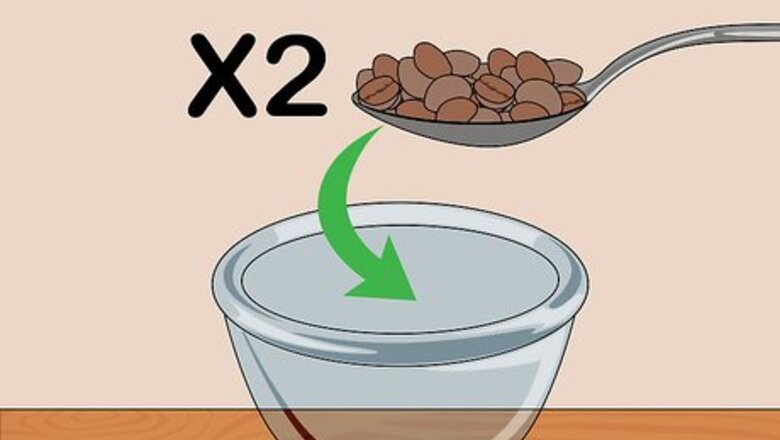
views
Measuring the Ingredients
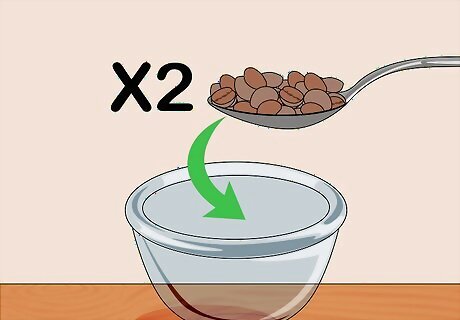
Measure the coffee. Turkish coffees are small beverages made with strong coffee. Each cup of coffee should be made with about 2 teaspoons (3.5 g) (also known as kasik of coffee) grounds. If you're working with whole beans that must be ground, measure 2 heaping teaspoons of beans for each coffee. Arabica beans are most often used for Turkish coffee, and Kurukahveci Mehmet Efendi is among the most popular brands.
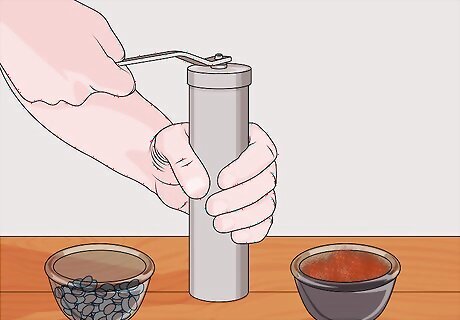
Grind the beans. Because Turkish coffee doesn’t get filtered, it’s important to grind the beans extremely finely. You can use a Turkish coffee mill if you have one, or use the finest setting on an electric grinder. You can also grind fresh beans at the grocery store, and many of these grinders have a Turkish coffee setting. Properly ground Turkish coffee beans will look like soft cocoa powder. Because the beans must be so finely ground, many people purchase pre-ground Turkish coffee blends.

Measure the water. Turkish coffee is served in a special cup known as a fincan. The easiest way to measure the water for the coffee is to pour the water into the fincan. Measure one and a half fincans worth of water for each coffee. This works out to about 1.7 ounces (50 ml) of water. For the best tasting coffee, always use water that’s cold and fresh.
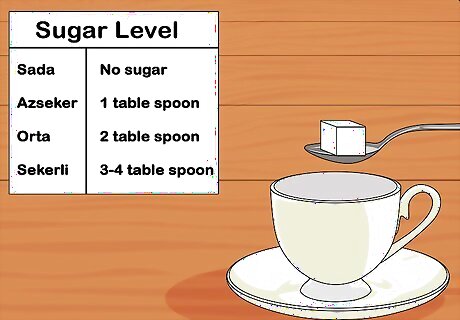
Measure the sugar. Sugar is an optional ingredient in Turkish coffee, and everybody has an individual preference. There are typically four sugar levels used to sweeten Turkish coffee: Sade: no sugar (unsweetened) Az seker: 1 teaspoon (4.5 g) of sugar (mildly sweet) Orta: 2 teaspoons (9 g) of sugar (sweet) Sekerli: 3 to 4 teaspoons (14 to 18.75 g) of sugar (very sweet)
Brewing the Coffee
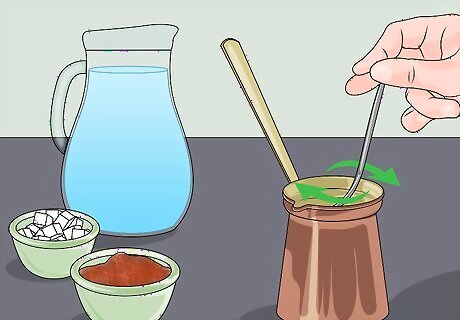
Combine the ingredients. Turkish coffee is brewed in a cezve (also called an ibrik). This is a small, long-handled pot made of brass or copper. Combine the coffee, water, and desired amount of sugar in the cezve and stir vigorously to combine all the ingredients. For an added spice, you can also stir in ⅛ teaspoon (0.25 g) of cardamom to the cezve, or a single cardamom pod. If you don’t have a cezve, you can use a small saucepan instead. A cezve can be purchased online, or from some specialty coffee shops.
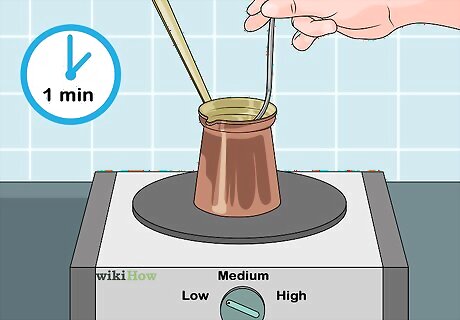
Heat the coffee. Turn a gas stove to low flame, or an electric stove to low heat. Place the pot on the heat and stir the ingredients together for one minute. After a minute, stop stirring and leave the coffee to brew. Keep the heat or flame low when you brew the coffee. You don’t want the water to boil, or it will change the flavor of the coffee and destroy the foam that you want to build.
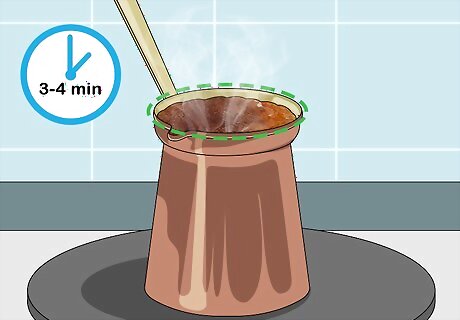
Brew the coffee until the foam forms. One of the most important elements of Turkish coffee is the foam that forms on top. As the coffee brews, the dark foam will build around the rim of the beverage. This will take three to four minutes. Pay close attention to the coffee as it brews to watch for the foam, but don’t stir it. If the coffee looks like it might begin to boil, remove it from the heat for a few seconds to cool it down.

Pour the foam into the cup. After three to four minutes, when the foam has formed on the top of the coffee, remove the cezve from the heat and pour the foam into your fincan. Then, return the cezve to the heat. To remove the foam from the cezve, you may have to use a spoon to help pour it out.
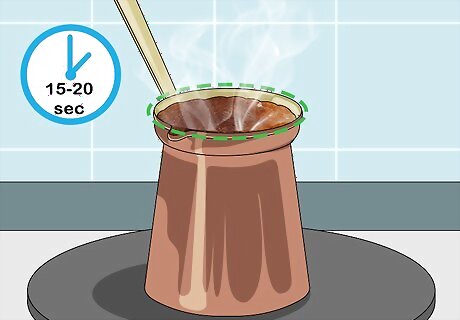
Continue heating the coffee. Brew the coffee for an additional 15 to 20 seconds after returning it to the heat.This will give the coffee a chance to raise again, which means coming close to a boil and creating new foam. Some traditions call for three to four raisings (removing the cezve from the heat, pouring out the foam, and returning it to the heat), whereas some say to do this once or not at all. You can experiment with different methods to find your preferred flavors.

Pour the coffee. After about 20 seconds, remove the cezve from the heat. Pour the full contents of the cezve into the fincan, foam, grounds, and all. Serve the coffee immediately while it’s still hot and fresh.
Serving and Drinking Turkish Coffee

Clean coffee spills from the glass. After pouring the coffee, use a damp cloth to clean any coffee that may have spilled on the rim or down the side of the fincan. Place the fincan on a saucer before serving it.

Serve the eldest guests first. In Turkey and many other areas of the world, it is considered disrespectful to serve younger guests before older ones. When you're making coffee for a group of people, always serve the coffee first to the older guests, and then serve according to age (from eldest to youngest).

Let the grounds settle before drinking. As the coffee cools in the fincan, the grounds will settle to the bottom. This will allow you to enjoy the coffee without drinking the grounds. Let the coffee sit for at least 30 seconds before taking your first sip.
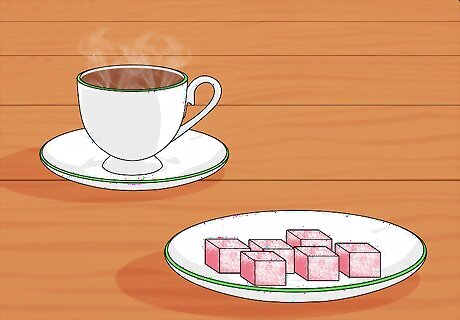
Serve the coffee with Turkish delight. Turkish coffee is often served with a few small treats or sweet snacks, and a piece of Turkish delight is a wonderful way to complement the coffee. Other treats you can serve with this coffee include: Cookies Chocolates Candies

Serve the coffee with a glass of water. Sipping water is a great way to clean your palate, so Turkish coffee is usually served with a glass of water. That way, you can take a sip before drinking the coffee and get the most enjoyment out of it.

Take small sips of the coffee. This type of coffee is small and strong, and it’s best consumed in small sips. Not only will this help the coffee last longer, but the air you breathe in when you sip will also help aerate the coffee and bring out its flavors.
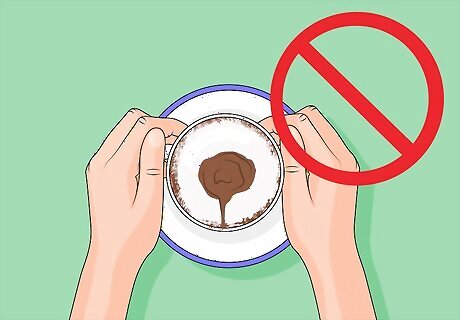
Don’t drink the last sip. The final one to two sips of Turkish coffee are coffee grounds that have settled on the bottom. When you get near the end of your coffee, set it down on the saucer without drinking the last bit, otherwise you'll get a mouthful of grounds.















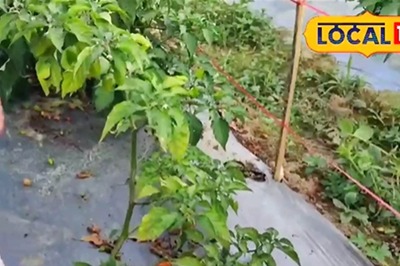


Comments
0 comment